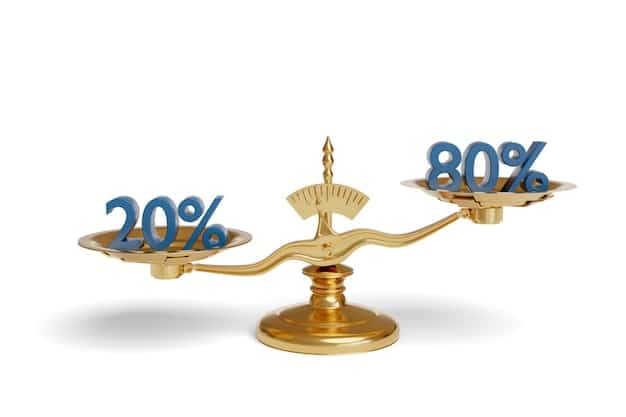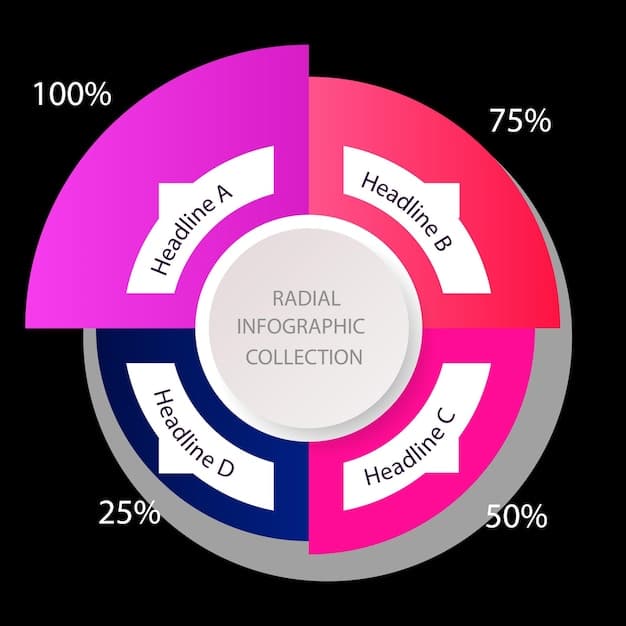Master Your Finances: The 50/30/20 Rule with Examples

Anúncios
The 50/30/20 rule is a simple yet effective budgeting technique that allocates 50% of your income to needs, 30% to wants, and 20% to savings and debt repayment, providing a clear framework for managing your finances and achieving financial goals.
Ready to take control of your finances? The 50/30/20 rule explained with real-life examples can be your roadmap to financial success. This straightforward budgeting method simplifies money management, helping you achieve your financial goals with ease.
Anúncios
Understanding the 50/30/20 Rule: A Simple Overview
The 50/30/20 rule is a budgeting guideline that divides your after-tax income into three categories: needs, wants, and savings/debt repayment. It’s a practical approach to managing your money effectively.
This rule helps you prioritize your spending and saving, making it easier to reach your financial objectives.
Anúncios
Breaking Down the Categories
Let’s dive deeper into each category to understand what they encompass:
- Needs (50%): These are essential expenses required for survival and daily living, such as housing, food, transportation, utilities, and healthcare.
- Wants (30%): These are non-essential expenses that enhance your lifestyle but aren’t crucial for survival. Examples include dining out, entertainment, travel, and hobbies.
- Savings/Debt Repayment (20%): This category includes savings for future goals like retirement, emergency funds, and investments, as well as paying off debts such as credit cards, student loans, and mortgages.
By adhering to these percentages, you can create a balanced budget that addresses both your present needs and future financial security.
Step-by-Step Guide to Implementing the 50/30/20 Rule
Implementing the 50/30/20 rule involves a few key steps to ensure you’re accurately categorizing your expenses and sticking to your budget.
Here’s a step-by-step guide to get you started:
Calculate Your After-Tax Income
The first step is to determine your net income, which is the amount you take home after taxes and other deductions. This is the base figure you’ll use to allocate your spending.
Track Your Expenses
Keep track of all your expenses for at least a month to understand where your money is going. You can use budgeting apps, spreadsheets, or even a notebook to monitor your spending habits.
Categorize Your Expenses
Once you have a clear picture of your spending, categorize each expense as either a need, want, or savings/debt repayment. Be honest with yourself to ensure accurate categorization.
Adjust Your Spending
Compare your current spending percentages to the 50/30/20 rule. If your spending in any category exceeds the recommended percentage, identify areas where you can cut back.
###Automate Your Savings
Set up automatic transfers to your savings and investment accounts to ensure you consistently allocate 20% of your income to this category. Automating this process makes it easier to save without having to think about it.
By following these steps, you can smoothly integrate the 50/30/20 rule into your financial routine.
Real-Life Examples of the 50/30/20 Rule in Action
To better illustrate how the 50/30/20 rule works, let’s look at a few real-life examples with different income levels and financial situations.
These examples will help you understand how to customize the rule to fit your specific needs and goals.
Example 1: Single Professional with $4,000 Monthly Income
Let’s consider a single professional who earns $4,000 per month after taxes. According to the 50/30/20 rule, their budget would break down as follows:
- Needs (50%): $2,000 (Rent, utilities, groceries, transportation, healthcare)
- Wants (30%): $1,200 (Dining out, entertainment, travel, hobbies)
- Savings/Debt Repayment (20%): $800 (Retirement savings, emergency fund, credit card debt)
Example 2: Young Couple with $8,000 Combined Monthly Income
Now, let’s look at a young couple with a combined after-tax income of $8,000 per month. Their budget might look like this:
- Needs (50%): $4,000 (Mortgage, utilities, groceries, transportation, childcare)
- Wants (30%): $2,400 (Dining out, entertainment, travel, hobbies)
- Savings/Debt Repayment (20%): $1,600 (Retirement savings, emergency fund, student loans)
Example 3: Family with $6,000 Monthly Income and Significant Debt
Finally, consider a family with an after-tax income of $6,000 per month and significant debt. Their budget might prioritize debt repayment:
- Needs (50%): $3,000 (Rent, utilities, groceries, transportation, healthcare)
- Wants (30%): $1,800 (Dining out, entertainment, hobbies)
- Savings/Debt Repayment (20%): $1,200 (Credit card debt, student loans, mortgage)
These examples demonstrate how the 50/30/20 rule can be adapted to different income levels and financial priorities.
Adjusting the 50/30/20 Rule to Fit Your Needs
While the 50/30/20 rule provides a solid foundation for budgeting, it’s essential to recognize that personal circumstances may require adjustments.
Here are some situations where you might need to modify the rule:
High Cost of Living
If you live in an area with a high cost of living, your needs may exceed 50% of your income. In this case, you may need to reduce your wants to stay within budget.
Significant Debt
If you have significant debt, you may want to allocate more than 20% of your income to debt repayment to become debt-free faster. This may require reducing both your wants and needs.
###Aggressive Savings Goals
If you have ambitious savings goals, such as saving for a down payment on a house or early retirement, you may want to allocate more than 20% of your income to savings. This can be achieved by cutting back on your wants and needs.
Irregular Income
If you have an irregular income, such as freelancers or self-employed individuals, you may need to average your income over several months to create a realistic budget. It’s also crucial to build a larger emergency fund to cover months with lower income.
By tailoring the 50/30/20 rule to your specific needs, you can create a budget that works for you.
Benefits of Using the 50/30/20 Rule
The 50/30/20 rule offers numerous benefits for individuals looking to improve their financial health. It’s a simple, effective, and flexible budgeting approach that can lead to financial stability and success.
Here are some key advantages of using the 50/30/20 rule:
Simplicity
The 50/30/20 rule is easy to understand and implement, making it accessible to people with varying levels of financial knowledge.
Flexibility
The rule can be adjusted to fit different income levels and financial situations, allowing you to customize it to your specific needs and goals.
Balance
The 50/30/20 rule strikes a balance between meeting your essential needs, enjoying your wants, and saving for the future, promoting a well-rounded financial life.
Financial Awareness
By tracking and categorizing your expenses, the 50/30/20 rule helps you become more aware of your spending habits and make informed financial decisions.
###Achieving Financial Goals
The rule provides a clear framework for saving and debt repayment, making it easier to achieve your financial goals, such as buying a house, paying off debt, or retiring early.
By embracing the 50/30/20 rule, you can take control of your finances and build a secure future.
Common Pitfalls to Avoid When Using the 50/30/20 Rule
While the 50/30/20 rule is straightforward, there are common mistakes that people make when implementing it. Avoiding these pitfalls can help you maximize the effectiveness of the rule.
Here are some common pitfalls to avoid:
Not Tracking Expenses Accurately
Failing to track your expenses accurately can lead to miscategorization and an inaccurate budget. Make sure to monitor your spending habits closely and be honest with yourself.
Overspending on Wants
It’s easy to overspend on wants, especially if you’re not mindful of your spending habits. Set realistic limits for your wants and avoid impulsive purchases.
###Ignoring Debt
Ignoring debt can derail your financial progress. Make sure to allocate enough of your income to debt repayment to avoid accumulating more debt and interest charges.
Failing to Adjust the Rule
Not adjusting the rule to fit your specific needs can lead to frustration and an ineffective budget. Be willing to modify the percentages as needed to accommodate your financial circumstances.
Not Reviewing Your Budget Regularly
Failing to review your budget regularly can result in spending drifting out of control. Schedule regular budget reviews to ensure you’re staying on track.
By avoiding these common pitfalls, you can ensure that the 50/30/20 rule works effectively for you.
| Key Point | Brief Description |
|---|---|
| 💰 Budget Categories | Divide income into needs (50%), wants (30%), and savings/debt (20%). |
| 📊 Expense Tracking | Monitor expenses to ensure they align with the 50/30/20 rule. |
| 🎯 Goal Setting | Customize the rule to fit specific financial goals and situations. |
| ✅ Avoid Pitfalls | Track accurately, avoid overspending, and review regularly. |
Frequently Asked Questions (FAQ)
▼
Needs are essential for survival (housing, food, transportation). Wants enhance lifestyle but aren’t essential (dining out, hobbies). Distinguishing them clearly is key to effective budgeting.
▼
Calculate your average monthly income over several months. Use this average to budget according to the 50/30/20 rule. Build a larger emergency fund for lean months.
▼
If needs exceed 50%, reduce your wants to stay within budget. Consider finding ways to lower your essential expenses, such as finding cheaper housing or transportation.
▼
Yes, the 20% can include savings and investments like retirement accounts or stocks. This portion should cover savings and other financial goals like debt repayment.
▼
Review your budget monthly to ensure you’re staying on track. Adjust it as needed to reflect changes in your income, expenses, or financial goals for optimal results.
Conclusion
In conclusion, the 50/30/20 rule explained with real-life examples offers a simple and effective way to manage your finances. By allocating your income wisely and making informed financial decisions, you can achieve your financial goals and build a secure future.







